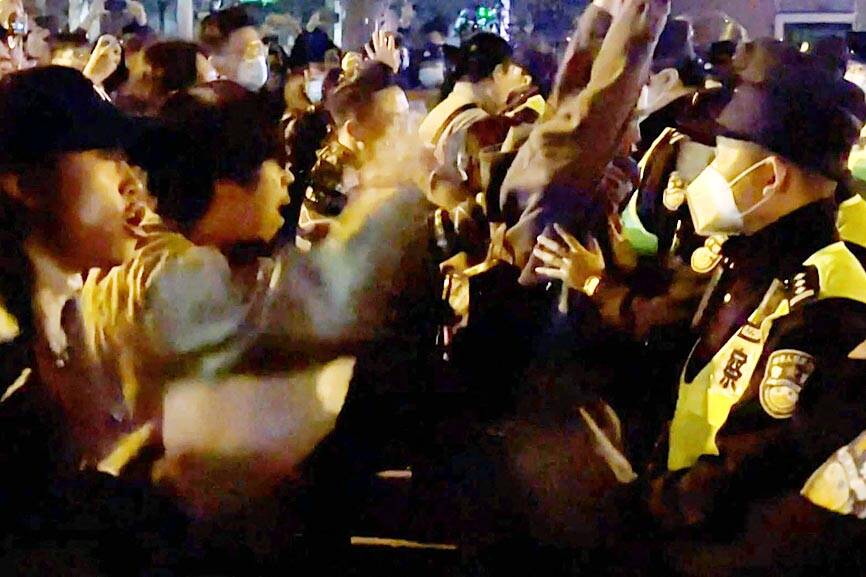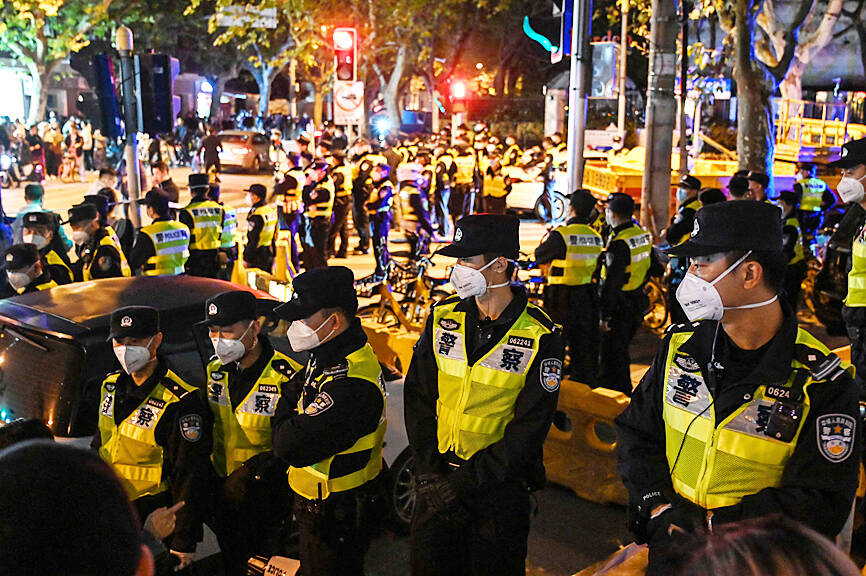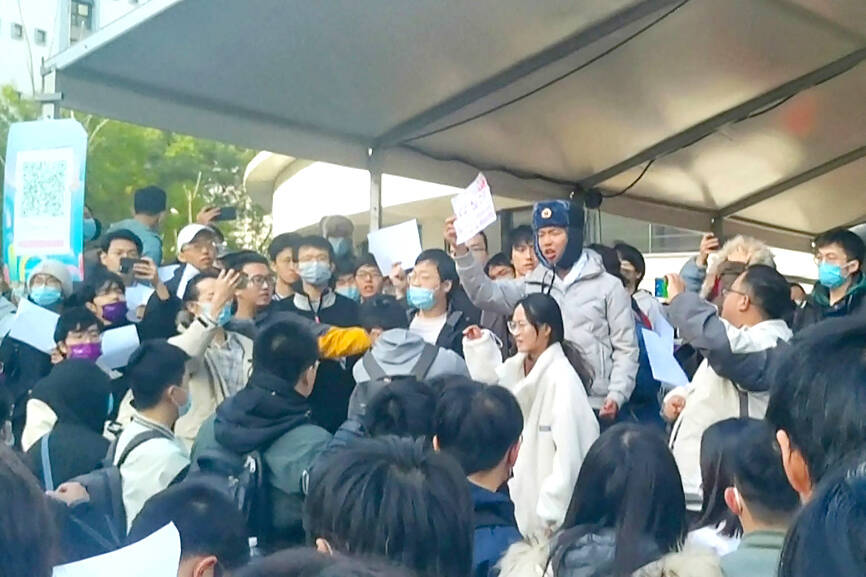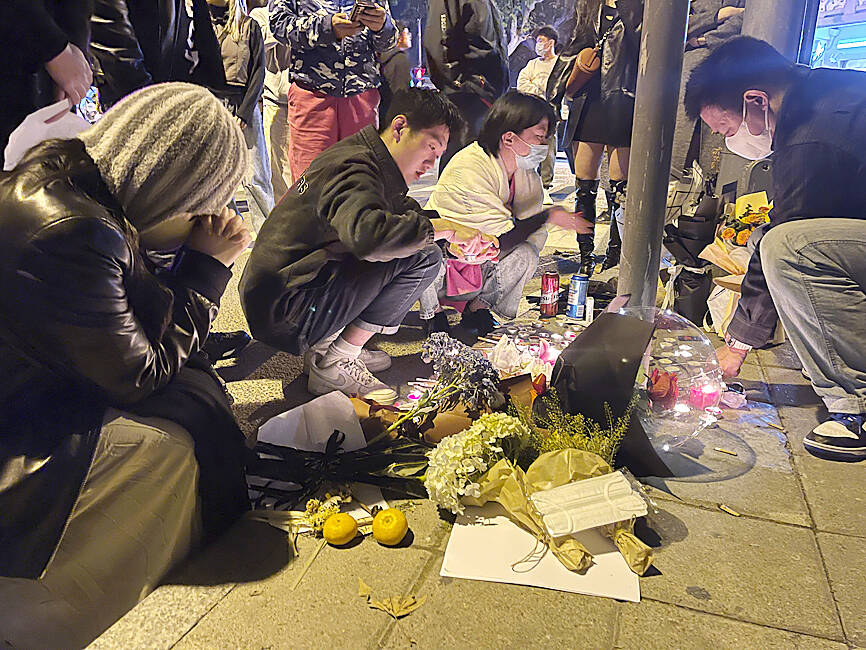Hundreds of people yesterday took to the streets in Beijing and Shanghai to protest China’s “zero COVID” policy in a rare outpouring of public anger against the state.
China’s hardline disease prevention strategy is stoking public frustration, with many growing weary of snap lockdowns, lengthy quarantines and mass testing campaigns.
A deadly fire on Thursday in Urumqi, the capital of China’s Xinjiang region, has become a fresh catalyst for anger, with many blaming lengthy COVID-19 lockdowns for hampering rescue efforts.

Photo: AFP
Authorities deny the claims.
Hundreds yesterday rallied at Beijing’s elite Tsinghua University to protest against lockdowns, said one witness who asked to remain anonymous.
“At 11:30am, students started holding up signs at the entrance of the canteen, then more and more people joined. Now there are 200 to 300 people,” the person said.

Photo: AFP
Participants sang the national anthem and The Internationale — a standard of the international communist movement — and chanted “freedom will prevail” and “no to lockdowns, we want freedom,” they said.
They described students holding up blank pieces of paper, a symbolic protest against censorship.
A video that appeared to be taken at the same location, but was quickly taken down, showed students shouting: “Democracy and the rule of law, freedom of expression.”

Photo: AFP
Other vigils took place overnight at universities across China, while videos from Xian, Guangzhou and Wuhan showed similar small protests.
Hundreds of people gathered in downtown Shanghai yesterday afternoon near where a demonstration had erupted just hours earlier, an eyewitness said.
Demonstrators holding blank pieces of paper and white flowers stood silently at several intersections, the person said, speaking on condition of anonymity.

Photo: AP
Footage from the area showed a crowd chanting during what appeared to be the late afternoon.
Later in the evening, an Agence France-Presse reporter saw a heavy security presence.
Dozens of police in yellow high-visibility jackets formed a thick line, cordoning off the streets where the protests had taken place, while their colleagues asked people to leave the area.
Crowds had gathered hours before on nearby Wulumuqi Street — named for Urumqi in Mandarin — with video showing protesters chanting: “Xi Jinping, step down; CCP, step down” in a rare display of public opposition to the Chinese Communist Party’s top leadership.
A person who attended the Shanghai protests but asked not to be identified said that the first rally was in full swing at 2am, with one group mourning the 10 people killed in the Urumqi fire, while another group chanted slogans.
Footage taken by an eyewitness showed a large crowd shouting and raising blank pieces of paper as they faced several lines of police.
Multiple witnesses said several people were taken away by the police.
Authorities were swift to curb online discussion of the protest, with related phrases scrubbed from Sina Weibo almost immediately after footage of the rallies emerged.
China’s state broadcaster is also cutting close-up shots of maskless fans at the FIFA World Cup in Qatar, after early coverage sparked anger at home.
During a live broadcast of yesterday’s group game between Japan and Costa Rica, state broadcaster CCTV Sports replaced close-up shots of maskless fans waving flags with images of players, officials or the soccer stadium.

SECURITY: As China is ‘reshaping’ Hong Kong’s population, Taiwan must raise the eligibility threshold for applications from Hong Kongers, Chiu Chui-cheng said When Hong Kong and Macau citizens apply for residency in Taiwan, it would be under a new category that includes a “national security observation period,” Mainland Affairs Council (MAC) Minister Chiu Chui-cheng (邱垂正) said yesterday. President William Lai (賴清德) on March 13 announced 17 strategies to counter China’s aggression toward Taiwan, including incorporating national security considerations into the review process for residency applications from Hong Kong and Macau citizens. The situation in Hong Kong is constantly changing, Chiu said to media yesterday on the sidelines of the Taipei Technology Run hosted by the Taipei Neihu Technology Park Development Association. With

A US Marine Corps regiment equipped with Naval Strike Missiles (NSM) is set to participate in the upcoming Balikatan 25 exercise in the Luzon Strait, marking the system’s first-ever deployment in the Philippines. US and Philippine officials have separately confirmed that the Navy Marine Expeditionary Ship Interdiction System (NMESIS) — the mobile launch platform for the Naval Strike Missile — would take part in the joint exercise. The missiles are being deployed to “a strategic first island chain chokepoint” in the waters between Taiwan proper and the Philippines, US-based Naval News reported. “The Luzon Strait and Bashi Channel represent a critical access

CARROT AND STICK: While unrelenting in its military threats, China attracted nearly 40,000 Taiwanese to over 400 business events last year Nearly 40,000 Taiwanese last year joined industry events in China, such as conferences and trade fairs, supported by the Chinese government, a study showed yesterday, as Beijing ramps up a charm offensive toward Taipei alongside military pressure. China has long taken a carrot-and-stick approach to Taiwan, threatening it with the prospect of military action while reaching out to those it believes are amenable to Beijing’s point of view. Taiwanese security officials are wary of what they see as Beijing’s influence campaigns to sway public opinion after Taipei and Beijing gradually resumed travel links halted by the COVID-19 pandemic, but the scale of

Pope Francis is be laid to rest on Saturday after lying in state for three days in St Peter’s Basilica, where the faithful are expected to flock to pay their respects to history’s first Latin American pontiff. The cardinals met yesterday in the Vatican’s synod hall to chart the next steps before a conclave begins to choose Francis’ successor, as condolences poured in from around the world. According to current norms, the conclave must begin between May 5 and 10. The cardinals set the funeral for Saturday at 10am in St Peter’s Square, to be celebrated by the dean of the College